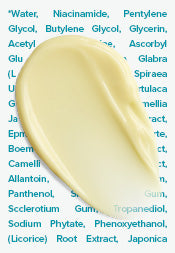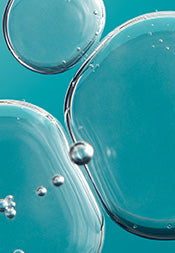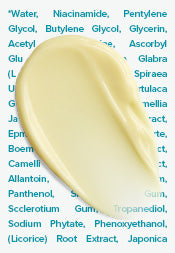Vitamin A Skincare Products 101
Over-the-counter retinol, also known as vitamin A, is one of the most effective skin restoring and transforming ingredients found in anti-ageing skincare like face creams, face serums, and eye creams. Ever wondered what retinol can do for your skin? Here’s your answer—it can minimise the appearance of wrinkles, improve uneven skin tone, shrink the look of enlarged pores, and reignite a feeling of firmness, making it ageing skin’s best friend. According to board-certified dermatologist Dr. Beth McLellan, “Retinoids have the best evidence for anti-ageing so every skin regimen should include sunscreen and a retinoid such as retinol.”
However, despite the mountain of research attesting to its benefits, many people are still unclear about how to use retinol and fit the appropriate skincare products into their routines. This quick overview will answer your questions—and help you transform your skin’s appearance.
How to choose the right vitamin A skincare product
Choosing the best vitamin A products for wrinkles is easier than you might think, but there are a few points to keep in mind:
- Packaging matters: Retinol is sensitive to air and light exposure, which means products will become ineffective if they’re packaged in jars or clear containers. Be sure that all the retinol facial creams or serums you purchase are packaged in opaque, airless, and/or air-restrictive containers.
- Choose vitamin A skincare products based on your skin type: Creams are generally the best product to incorporate into dry skincare routines, lotions for normal to combination skin, and serums or gels for oily or congested skin.
- Personal choice matters too: That said, it’s also fine to choose a retinol facial product based on its texture or your personal preference. Find one that pairs well with the other items in your routine, that feels good on your skin, and that delivers results.
- Experiment till you find the perfect fit: If an over-the-counter retinol cream or serum doesn’t seem to be working well for you and your skin after a few weeks, try another. It might take some experimenting to find your perfect match.
- Look into other ingredients: When looking for retinol for the skin, you’ll also see vitamin A derivatives like retinyl palmitate, retinaldehyde, retinyl retinoate, and retinyl propionate widely used in skincare products—though retinol is by far the most researched form. That doesn’t mean these other forms don’t work, just that pure over-the-counter retinol has more history behind it.
How much vitamin A should be used?
There isn’t a single best over-the-counter vitamin A product for the skin. This is exactly why Paula’s Choice offers various textures and strengths: so you can find the one that’s right for your skin type and skin concerns.
Our advice? If you are a new vitamin A user, begin with a lower concentration serum or moisturiser with retinol. If you’ve used retinol in the past and had great results, consider a moderate-strength retinol serum. And, for more tenacious concerns like deep wrinkles and a pronounced uneven skin tone, look to one of our high-strength vitamin A products for skin like the Clinical 1% Retinol Treatment. You can also alternate between lower and higher strengths and determine which works best for your skin based on how it responds. According to Dr. McLellan, “I always tell patients ‘there’s a retinol for everyone’ – some of my patients with sensitive skin just need to start slow and build up to stronger versions over time.”
How to incorporate vitamin A skincare products into your routine
Now, to address the age old question — can you use retinol during the day? We recommend them as part of a nightly skincare routine, when most people don’t mind adding an extra step or two. But it’s also fine to use retinol in the daytime, as long as you finish with a broad-spectrum sunscreen rated SPF 30 or greater.
As always, cleanse first, followed by the use of a facial toner, and then apply your BHA or AHA exfoliant*. You don’t need to wait for the retinol to be absorbed into your skin before applying other products. You can apply your other products immediately after, but always begin with the lightest textures first, like the water-based ones. Finish with the creamiest or thickest product. For example, if your retinol product has a fluid texture, you’d apply it directly after your AHA or BHA exfoliant and follow with the other products in your routine. If it’s a cream or lotion, first apply your lightweight booster, essence, treatment, or fluid serum products, and finish with the retinol cream. If you’re using a rich, creamy moisturiser as well, apply that last.
Don’t forget—when you apply your retinol product, be sure to include your neck and chest so you get those amazing benefits there too. Also, note that improving the appearance of ageing skin is too complex for any one ingredient to handle—even a superstar like retinol. So, for best results, combine it with:
- Other anti-ageing, skin restoring ingredients like antioxidants.
- Products that have visibly restorative ingredients like niacinamide andpeptides.
- Products with skin-replenishing ingredients such as hyaluronic acid and ceramides.
*For the best anti-ageing benefits, it’s ideal to use both an exfoliant and a retinol cream as part of your regular skincare routine. Retinol doesn’t exfoliate skin— that’s a common misperception because retinol causes flaking skin (irritant contact dermatitis) for some people. Retinol can help normalise skin’s normal surface cell shedding, which can become sluggish for numerous reasons.
Learn more about retinol here.
Explore our range of anti-ageing retinol products suitable for all skin types.
References for this information
Clinics in Dermatology, April 2019, ePublication
International Journal of Cosmetic Science, February 2017, pages 56-65
Journal of Cosmetic Dermatology, March 2016, pages 49-57
Journal of Drugs in Dermatology, March 2015, pages 271-280
Dermatology, May 2014, pages 314–325
Toxicological Research, March 2010, pages 61–66
The Journal of Pathology, January 2007, pages 241–251
Clinical Interventions in Aging, December 2006, pages 327–348
Recommended Products
CLINICAL 1% Retinol Treatment
RESIST Barrier Repair Moisturizer
CLINICAL 0.3% Retinol + 2% Bakuchiol Treatment












